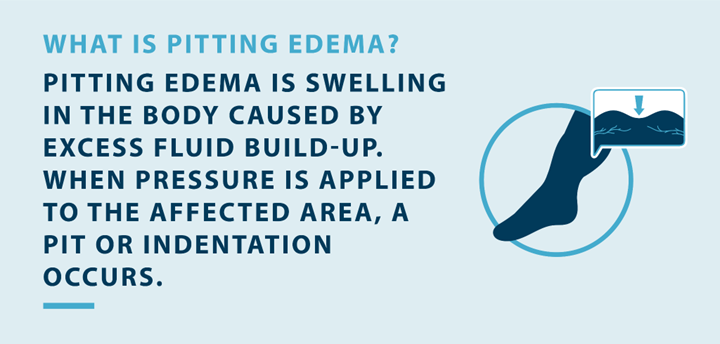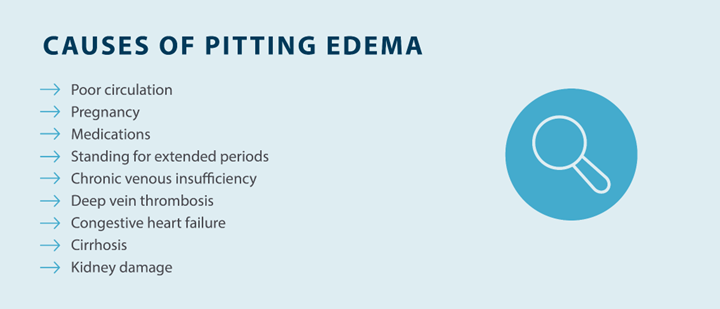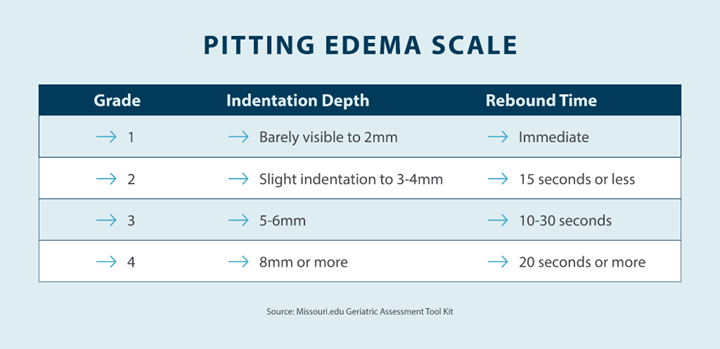Peripheral Edema
Review our guide on peripheral edema to learn about its symptoms, causes, and treatment, so you can manage your condition.
Read More

Pitting edema is a condition where an indentation, or pit, is left on the skin when sustained pressure is applied to an area of a person’s body that’s affected by edema. Fortunately, there are treatment options for people that present with pitting edema that can help provide relief and reduce swelling that’s associated with this condition.
So, what is pitting edema compared to non-pitting edema, and should you be worried about pitting edema? It’s best to get a proper diagnosis from a doctor, but understanding pitting edema can help you identify any symptoms and encourage you to find the right interventions. In this article, we’ll cover what pitting edema is, what causes pitting edema, how it’s treated, the risk factors, and more.
Pitting edema occurs when an indent is left after a finger is pressed down on the area of the body affected by edema. Edema itself is a condition where excess fluid accumulates in the body’s tissues, leading to swelling that typically affects the extremities, such as the arms, legs, hands, and feet, but can occur anywhere in the body. Several conditions can cause pitting edema, so it’s important to visit a doctor to get a diagnosis and create a treatment plan that works for you.

Edema can be classified as pitting or non-pitting. The main difference between pitting edema and non-pitting edema is the indentation. With non-pitting edema, no indentation is left after pressure is applied to the swollen area. Edema is considered pitting edema when pressing your finger on the area leaves an indentation. Pitting can be an indicator of the severity of edema, so it’s important to identify this sign to receive a proper diagnosis.
There are several factors that can cause pitting edema, and understanding the potential causes can help you reduce your risk of edema. Take a look at what causes pitting edema below:

It’s important to keep in mind that pitting edema may or may not be a result of lymphedema. Consulting with your doctor or a lymphedema specialist can help you get the proper diagnosis.
There are several risk factors associated with pitting edema, which is why identifying it in its early stages is crucial. Lifestyle choices are one of the most significant risk factors for pitting edema. For example, there is a higher risk of developing pitting edema if your diet consists of food with a high sodium content that causes you to retain more water. You’re also more likely to develop pitting edema if you live a sedentary lifestyle.
Other risk factors for pitting edema include thyroid conditions and other chronic illnesses. For example, pitting edema can be related to kidney disease or heart disease. Edema can also be caused by lymph fluid, known as lymphedema, which results in the swelling of the arm, leg, head, or neck.
Recognizing the symptoms of pitting edema can help you seek the necessary interventions to manage and relieve symptoms associated with pitting edema. The most common symptom of pitting edema is when the skin in the affected area is depressed with your finger for several seconds and the indentation does not immediately disappear. However, additional symptoms may be present with pitting edema, such as:
These are some of the symptoms you may experience with pitting edema. If you’re experiencing any of these signs, consult with your doctor or lymphedema specialist for a proper diagnosis and treatment plan.
Getting a professional diagnosis is important if you’re experiencing symptoms related to pitting edema. When working with your doctor, they will start by reviewing your medical history to identify potential causes and risk factors of pitting edema. This is an important part of determining the cause of your edema, which allows you to start pitting edema treatment.
A physical exam is also used to diagnose pitting edema based on the depth of the depression and how quickly it rebounds. There are four grades of pitting edema:

Aside from using the pitting edema scale, doctors and specialists may also use a handful of lab tests to help diagnose pitting edema. Blood tests may be performed depending on the underlying cause of pitting edema, but they can’t detect every potential underlying condition. For conditions blood tests can’t detect, your doctor may use X-rays or an ultrasound exam to diagnose pitting edema.
Treating pitting edema is an important step in managing the symptoms of this condition and reducing its progression. Pitting edema can be treated with lifestyle changes, elevation, compression garments, and more.
For lifestyle changes, it’s recommended to avoid high-sodium diets and to get regular exercise. Light exercise can encourage the movement of fluids flowing throughout your body and reduce swelling.
Another treatment option is elevating the affected limb. By elevating the limb that’s filled with fluid, you can encourage drainage and reduce some of the swelling. Another lymphedema treatment and management recommendation is wearing compression garments, such as sleeves and stockings. Compression garments encourage blood flow by using gradual compression, which can help reduce swelling and relieve pain.
Pneumatic compression devices are also great at-home management options. Tactile Medical’s Flexitouch Plus system is designed for the upper body, lower body, and head and neck. By stimulating the lymphatic system and encouraging the flow of lymphatic fluid, Flexitouch Plus can help relieve swelling, pain, and other symptoms associated with lymphedema. When wearing the Flexitouch Plus garments, mild, dynamic pressure is delivered in 1-3 second intervals to create a gentle work and release action to direct fluid across the body’s watershed. At Tactile Medical, we’ll work with you and your doctor to find a treatment option that works for you.
Pitting edema occurs when the skin is depressed with your finger for a few seconds and an indentation is left that does not immediately disappear. Patients living with pitting edema can experience a decrease in their quality of life, especially if causing pain.
Fortunately, there are several ways to reduce your risk of pitting edema, along with various management and treatment options to reduce swelling and prevent the progression of this disease. If you’re experiencing the signs and symptoms associated with pitting edema, visit a doctor for a diagnosis as soon as possible. At Tactile Medical, we have doctor-prescribed compression devices that you can use to manage your symptoms from the comfort of your home.
Review our guide on peripheral edema to learn about its symptoms, causes, and treatment, so you can manage your condition.
Read More
Review our guide on the differences between inflammation vs. swelling, so you can understand how they impact your body differently.
Read More
Review our guide on chronic venous insufficiency (CVI) to better understand the symptoms, causes, and treatment options to get the care you need.
Read More
Read More
Call us at 1.800.575.1900